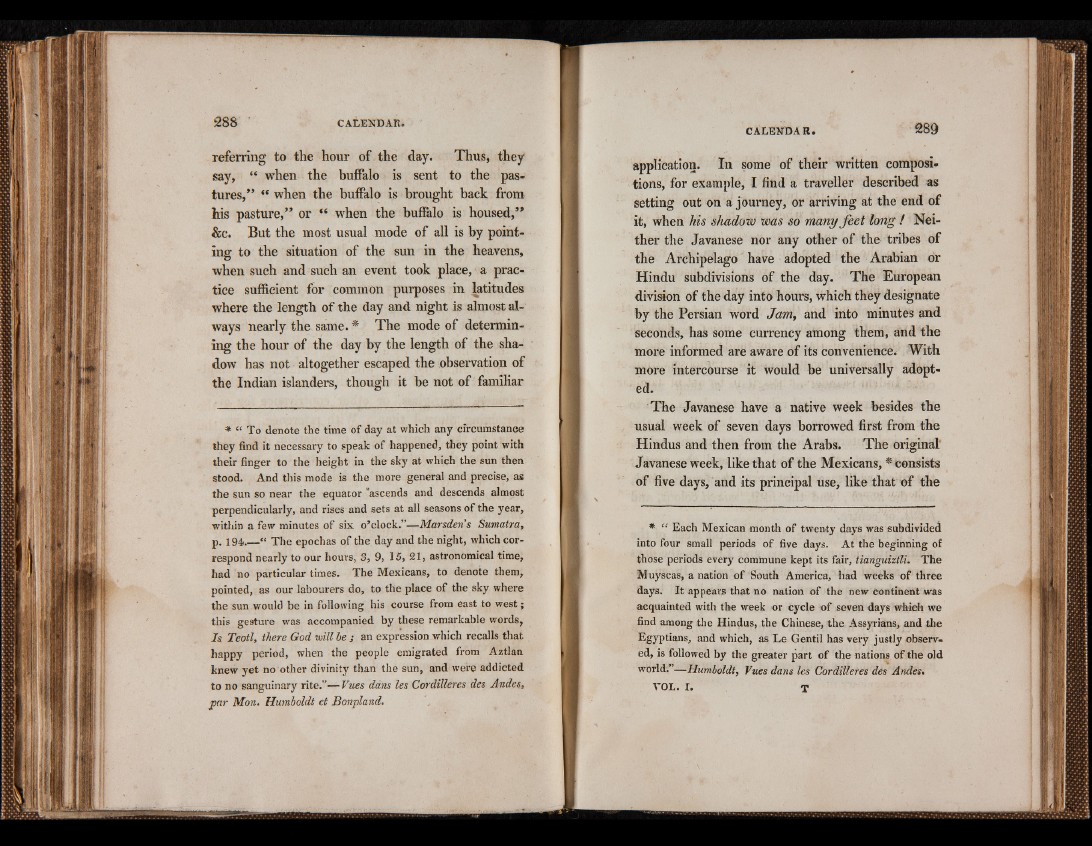
referring to the hour of the day. Thus, they
say, “ when the buffalo is sent to the pastures,”
“ when the buffalo is brought back from
his pasture,” or “ when the buffalo is housed,”
&c. But the most usual mode of all is by pointing
to the situation of the sun in the heavens,
when such and such an event took place, a practice
sufficient for common purposes in latitudes
where the length of the day and night is almost always
nearly the same. * The mode of determining
the hour of the day by the length of the shadow
has not altogether escaped the observation of
the Indian islanders, though it be not of familiar
* “ To denote the time of day at which any circumstance
they find it necessary to speak of happened, they point with
their finger to the height in the sky at which the sun then
stood. And this mode is the more general and precise, as
the sun so near the equator 'ascends and descends almost
perpendicularly, and rises and sets at all seasons of the year,
within a few minutes of six o’clock.”—Marsden’s Sumatra,
p. 194.—“ The epochas of the day and the night, which correspond
nearly to our hours, 3, 9, 15, 21, astronomical time,
had no particular times. The Mexicans, to denote them,
pointed, as our labourers do, to the place of the sky where
the sun would be in following his course from east to west;
this gesture was accompanied by these remarkable words,
Is. Teotl, there God toill he ; an expression which recalls that
happy period, when the people emigrated from Aztlan
knew yet no other divinity than the sun, and were addicted
to no sanguinary rite.”— Vues dans les Cordilleres des Andes,
par Mon. Humboldt et Bonpland.
application. In some of their written compositions,
for example, I find a traveller described as
setting out on a journey, or arriving at the end of
it, when his shadow was so many feet long ! Neither
the Javanese nor any other of the tribes of
the Archipelago have adopted the Arabian or
Hindu subdivisions of the day. The European
division of the day into hours, which they designate
by the Persian word Jam, and into minutes and
seconds, has some currency among them, and the
more informed are aware of its convenience. With
more intercourse it would be universally adopted.
The Javanese have a native week besides the
usual week of seven days borrowed first from the
Hindus and then from the Arabs. The original'
Javanese week, like that of the Mexicans, * consists
of five days, and its principal use, like that of the
* “ Each Mexican month of twenty days was subdivided
into four small periods of five days. At the beginning oE
those periods every commune kept its fair, tianguiztli. The
Muyscas, a nation of South America, had weeks of three
days. I t appears that no nation of the new continent was
acquainted with the week or cycle of seven days which we
find among the Hindus, the Chinese, the Assyrians, and the
Egyptians, and which, as Le Gentil has very justly observed,
is followed by the greater part of the nations of the old
world.”—Humboldt, Vues dans les Cordilleres des Andes.
VOL. I . T